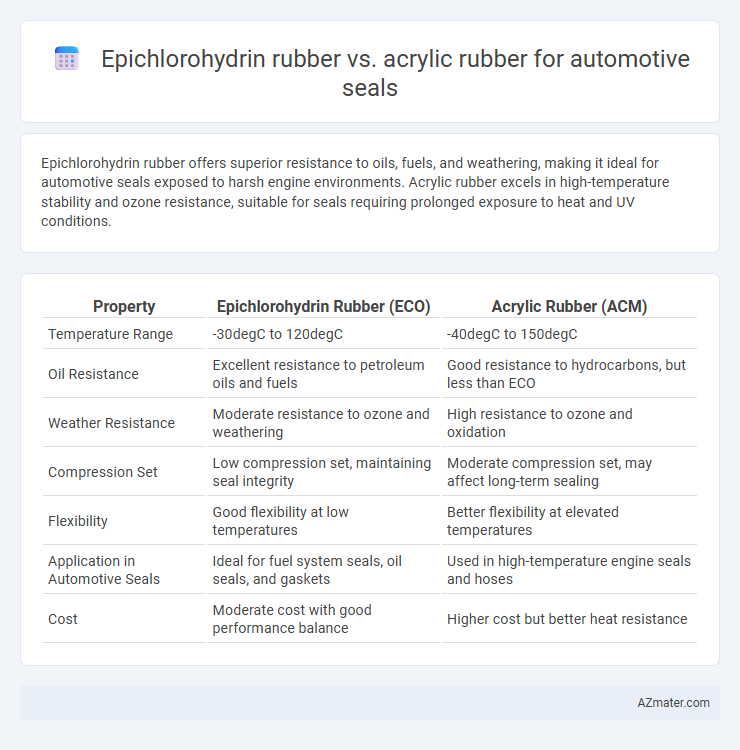Epichlorohydrin rubber offers superior resistance to oils, fuels, and weathering, making it ideal for automotive seals exposed to harsh engine environments. Acrylic rubber excels in high-temperature stability and ozone resistance, suitable for seals requiring prolonged exposure to heat and UV conditions.
Table of Comparison
| Property | Epichlorohydrin Rubber (ECO) | Acrylic Rubber (ACM) |
|---|---|---|
| Temperature Range | -30degC to 120degC | -40degC to 150degC |
| Oil Resistance | Excellent resistance to petroleum oils and fuels | Good resistance to hydrocarbons, but less than ECO |
| Weather Resistance | Moderate resistance to ozone and weathering | High resistance to ozone and oxidation |
| Compression Set | Low compression set, maintaining seal integrity | Moderate compression set, may affect long-term sealing |
| Flexibility | Good flexibility at low temperatures | Better flexibility at elevated temperatures |
| Application in Automotive Seals | Ideal for fuel system seals, oil seals, and gaskets | Used in high-temperature engine seals and hoses |
| Cost | Moderate cost with good performance balance | Higher cost but better heat resistance |
Introduction to Automotive Seal Materials
Epichlorohydrin rubber (ECO) offers excellent resistance to ozone, weathering, and oil, making it suitable for automotive seals exposed to harsh environments, especially in engine compartments. Acrylic rubber (ACM) provides superior heat resistance up to 170degC and excellent resistance to automotive fluids like transmission fluids, ideal for seals in engines and transmissions. Both materials ensure durable performance, but ECO is preferred for cold weather flexibility while ACM excels in high-temperature applications within automotive sealing systems.
Overview of Epichlorohydrin Rubber (ECO)
Epichlorohydrin Rubber (ECO) is a synthetic elastomer known for its excellent resistance to oils, fuels, and weathering, making it ideal for automotive seals exposed to harsh environments. ECO offers superior impermeability to gases and fluids compared to Acrylic Rubber (ACM), along with good low-temperature flexibility and ozone resistance. Its chemical structure enhances compatibility with polar fluids and hydraulic fluids, ensuring durable performance in engine and transmission sealing applications.
Overview of Acrylic Rubber (ACM)
Acrylic rubber (ACM) is a synthetic elastomer characterized by excellent resistance to heat, ozone, and weathering, making it ideal for automotive seals exposed to high temperatures and harsh environmental conditions. Its superior oil and fuel resistance compared to epichlorohydrin rubber enhances durability in engine compartments and fuel systems. ACM's balance of mechanical properties and chemical stability supports longevity and performance in automotive sealing applications.
Chemical Resistance Comparison
Epichlorohydrin rubber exhibits superior chemical resistance to oils, greases, and fuel, making it highly suitable for automotive seals exposed to engine fluids and harsh chemicals. Acrylic rubber, while offering excellent resistance to hot oils and oxidation, generally shows lower resistance to amines, ketones, and alcohols compared to epichlorohydrin. The enhanced chemical stability of epichlorohydrin rubber ensures longer seal life in diverse automotive environments where exposure to multiple aggressive substances is common.
Temperature Performance and Flexibility
Epichlorohydrin rubber (ECO) offers superior temperature resistance, typically performing well between -40degC and 130degC, making it suitable for automotive seals exposed to moderate heat and chemical environments. Acrylic rubber (ACM) excels in high-temperature applications, withstanding continuous exposure up to 150degC, and provides excellent resistance to oxidation and ozone aging. While ECO maintains better flexibility at low temperatures, enhancing seal integrity in colder climates, ACM tends to be less flexible but more durable under prolonged thermal stress.
Ozone and Weathering Resistance
Epichlorohydrin rubber (ECO) offers superior ozone and weathering resistance compared to acrylic rubber, making it highly suitable for automotive seals exposed to harsh environmental conditions. ECO's molecular structure provides enhanced protection against ozone cracking and degradation caused by UV radiation, ensuring long-lasting durability in seal applications. Acrylic rubber, while offering good heat resistance, generally lacks the same level of ozone and weathering resilience, which can reduce its performance lifespan in exterior automotive sealing components.
Oil and Fuel Resistance
Epichlorohydrin rubber exhibits superior oil and fuel resistance compared to acrylic rubber, making it a preferred material for automotive seals exposed to harsh lubricants and fuels. Its molecular structure provides excellent resistance to swelling, degradation, and permeation when in contact with hydrocarbons, oils, and fuels. Acrylic rubber, while offering good general chemical resistance, lacks the robustness of epichlorohydrin in prolonged exposure to aggressive automotive fluids, limiting its suitability for high-performance sealing applications.
Cost and Manufacturing Considerations
Epichlorohydrin rubber offers superior resistance to oils, fuels, and weathering, making it highly suitable for automotive seals but tends to be more expensive due to complex polymerization processes. Acrylic rubber, while generally more cost-effective and easier to process with faster curing times, exhibits moderate resistance to heat and chemicals, which may limit its application in demanding automotive environments. Manufacturing considerations include epichlorohydrin's need for precise temperature control during vulcanization, contrasting with acrylic rubber's compatibility with standard mixing and molding equipment, influencing overall production efficiency and cost-effectiveness.
Typical Automotive Seal Applications
Epichlorohydrin rubber (ECO) offers superior resistance to oil, heat, and weathering, making it ideal for automotive seals exposed to hydraulic fluids and engine oils, such as fuel system seals, transmission seals, and coolant system gaskets. Acrylic rubber (ACM) excels in high-temperature environments with excellent resistance to ozone, heat aging, and automotive exhaust gases, commonly used in heater hose seals, transmission seals, and fuel system components. Both materials support durable seal performance, but Epichlorohydrin is preferred for resistance to polar solvents while Acrylic rubber suits high-temperature, low-swelling applications in automotive sealing.
Conclusion: Selection Criteria for ECO vs ACM
Selection between Epichlorohydrin (ECO) and Acrylic (ACM) rubber for automotive seals depends primarily on chemical resistance, temperature range, and ozone resistance. ECO rubber excels in fuel and oil resistance with a temperature range of -40degC to 120degC, making it ideal for fuel system seals. ACM rubber offers superior high-temperature stability up to 150degC and excellent resistance to heat aging and ozone, but with lower fuel resistance, guiding manufacturers to choose based on specific environmental exposure and mechanical demands.

Infographic: Epichlorohydrin rubber vs Acrylic rubber for Automotive seal
 azmater.com
azmater.com